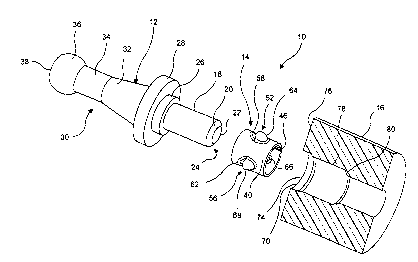Some of the information on this Web page has been provided by external sources. The Government of Canada is not responsible for the accuracy, reliability or currency of the information supplied by external sources. Users wishing to rely upon this information should consult directly with the source of the information. Content provided by external sources is not subject to official languages, privacy and accessibility requirements.
Any discrepancies in the text and image of the Claims and Abstract are due to differing posting times. Text of the Claims and Abstract are posted:
| (12) Patent Application: | (11) CA 2317298 |
|---|---|
| (54) English Title: | BLIND APERTURE FASTENER |
| (54) French Title: | FIXATION POUR EVIDEMENT AVEUGLE |
| Status: | Deemed Abandoned and Beyond the Period of Reinstatement - Pending Response to Notice of Disregarded Communication |
| (51) International Patent Classification (IPC): |
|
|---|---|
| (72) Inventors : |
|
| (73) Owners : |
|
| (71) Applicants : |
|
| (74) Agent: | FINLAYSON & SINGLEHURST |
| (74) Associate agent: | |
| (45) Issued: | |
| (22) Filed Date: | 2000-08-31 |
| (41) Open to Public Inspection: | 2001-04-05 |
| Examination requested: | 2000-08-31 |
| Availability of licence: | N/A |
| Dedicated to the Public: | N/A |
| (25) Language of filing: | English |
| Patent Cooperation Treaty (PCT): | No |
|---|
| (30) Application Priority Data: | ||||||
|---|---|---|---|---|---|---|
|
The fastener includes a stud with a post element, a
cylindrical inner sleeve with inwardly extending half-hemispherical
bosses immediately adjacent to outwardly extending
half-hemispherical bosses, and a base element with a blind aperture.
The inner sleeve is received within the blind aperture and the post
element is received within the inner sleeve. The pressure exerted
upon the insertion of the post element of the stud and the
structure of the bosses cause the inner sleeve to cock into a
locked position. The exposed edges of the inwardly extending
half-hemispherical bosses of the inner sleeve engage the post element
while the exposed edges of the outwardly extending
half-hemispherical bosses of the inner sleeve engage the walls of the
blind aperture in order to resist the subsequent withdrawal of the
post element from the blind aperture.
Note: Claims are shown in the official language in which they were submitted.
Note: Descriptions are shown in the official language in which they were submitted.

2024-08-01:As part of the Next Generation Patents (NGP) transition, the Canadian Patents Database (CPD) now contains a more detailed Event History, which replicates the Event Log of our new back-office solution.
Please note that "Inactive:" events refers to events no longer in use in our new back-office solution.
For a clearer understanding of the status of the application/patent presented on this page, the site Disclaimer , as well as the definitions for Patent , Event History , Maintenance Fee and Payment History should be consulted.
| Description | Date |
|---|---|
| Inactive: IPC from MCD | 2006-03-12 |
| Application Not Reinstated by Deadline | 2004-08-09 |
| Inactive: Dead - No reply to s.30(2) Rules requisition | 2004-08-09 |
| Deemed Abandoned - Failure to Respond to Maintenance Fee Notice | 2003-09-02 |
| Inactive: Abandoned - No reply to s.30(2) Rules requisition | 2003-08-07 |
| Inactive: S.30(2) Rules - Examiner requisition | 2003-02-07 |
| Application Published (Open to Public Inspection) | 2001-04-05 |
| Inactive: Cover page published | 2001-04-04 |
| Inactive: First IPC assigned | 2000-10-11 |
| Filing Requirements Determined Compliant | 2000-09-21 |
| Letter Sent | 2000-09-21 |
| Inactive: Filing certificate - RFE (English) | 2000-09-21 |
| Application Received - Regular National | 2000-09-20 |
| Request for Examination Requirements Determined Compliant | 2000-08-31 |
| All Requirements for Examination Determined Compliant | 2000-08-31 |
| Abandonment Date | Reason | Reinstatement Date |
|---|---|---|
| 2003-09-02 |
The last payment was received on 2002-08-13
Note : If the full payment has not been received on or before the date indicated, a further fee may be required which may be one of the following
Patent fees are adjusted on the 1st of January every year. The amounts above are the current amounts if received by December 31 of the current year.
Please refer to the CIPO
Patent Fees
web page to see all current fee amounts.
| Fee Type | Anniversary Year | Due Date | Paid Date |
|---|---|---|---|
| Application fee - standard | 2000-08-31 | ||
| Registration of a document | 2000-08-31 | ||
| Request for examination - standard | 2000-08-31 | ||
| MF (application, 2nd anniv.) - standard | 02 | 2002-09-02 | 2002-08-13 |
Note: Records showing the ownership history in alphabetical order.
| Current Owners on Record |
|---|
| ILLINOIS TOOL WORKS INC. |
| Past Owners on Record |
|---|
| KEN LEVEY |